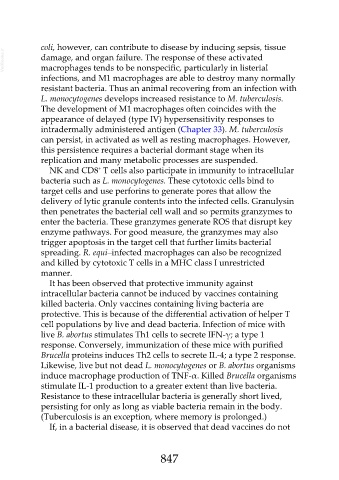Page 847 - Veterinary Immunology, 10th Edition
P. 847
coli, however, can contribute to disease by inducing sepsis, tissue
VetBooks.ir damage, and organ failure. The response of these activated
macrophages tends to be nonspecific, particularly in listerial
infections, and M1 macrophages are able to destroy many normally
resistant bacteria. Thus an animal recovering from an infection with
L. monocytogenes develops increased resistance to M. tuberculosis.
The development of M1 macrophages often coincides with the
appearance of delayed (type IV) hypersensitivity responses to
intradermally administered antigen (Chapter 33). M. tuberculosis
can persist, in activated as well as resting macrophages. However,
this persistence requires a bacterial dormant stage when its
replication and many metabolic processes are suspended.
+
NK and CD8 T cells also participate in immunity to intracellular
bacteria such as L. monocytogenes. These cytotoxic cells bind to
target cells and use perforins to generate pores that allow the
delivery of lytic granule contents into the infected cells. Granulysin
then penetrates the bacterial cell wall and so permits granzymes to
enter the bacteria. These granzymes generate ROS that disrupt key
enzyme pathways. For good measure, the granzymes may also
trigger apoptosis in the target cell that further limits bacterial
spreading. R. equi–infected macrophages can also be recognized
and killed by cytotoxic T cells in a MHC class I unrestricted
manner.
It has been observed that protective immunity against
intracellular bacteria cannot be induced by vaccines containing
killed bacteria. Only vaccines containing living bacteria are
protective. This is because of the differential activation of helper T
cell populations by live and dead bacteria. Infection of mice with
live B. abortus stimulates Th1 cells to secrete IFN-γ; a type 1
response. Conversely, immunization of these mice with purified
Brucella proteins induces Th2 cells to secrete IL-4; a type 2 response.
Likewise, live but not dead L. monocytogenes or B. abortus organisms
induce macrophage production of TNF-α. Killed Brucella organisms
stimulate IL-1 production to a greater extent than live bacteria.
Resistance to these intracellular bacteria is generally short lived,
persisting for only as long as viable bacteria remain in the body.
(Tuberculosis is an exception, where memory is prolonged.)
If, in a bacterial disease, it is observed that dead vaccines do not
847

